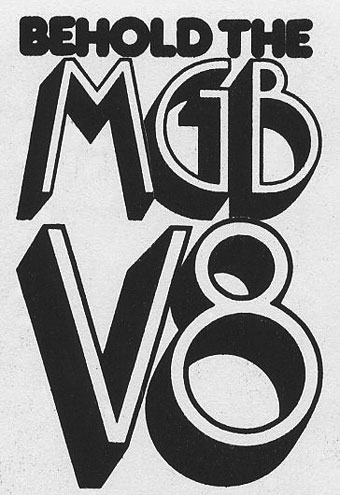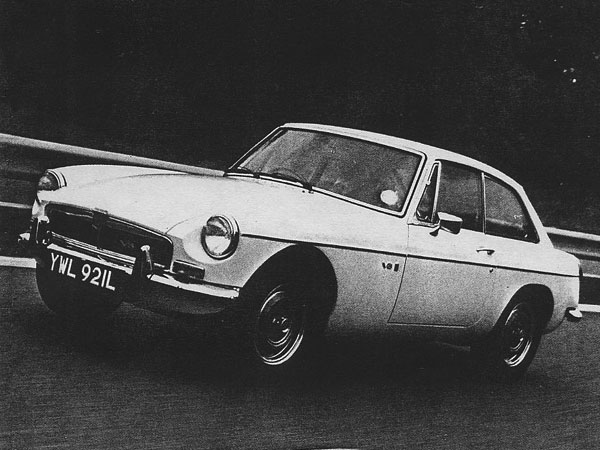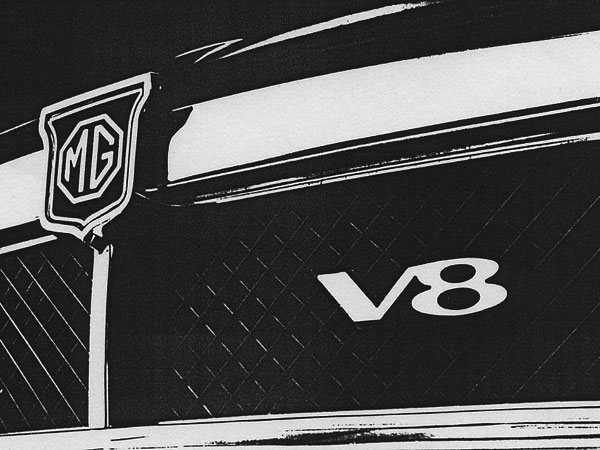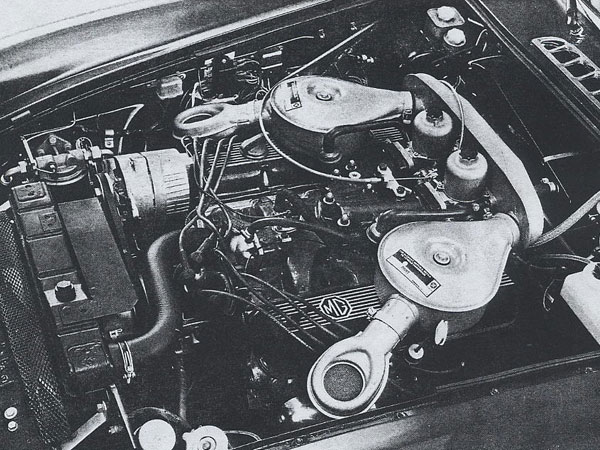�
Behold the MGB V8� as published in BritishV8 Magazine,� Volume XVI Issue 2, October 2008� � Re-printed unedited by exclusive permission of "Australian Motor Manual". � This article originally appeared in their issue for October 1973.� � by: Armstrong� � A NEW MG is always news, because it doesn't happen very often and, although � the MGB GT V8 (whew, what a mouthful!) is a hybrid, it is the fastest, smoothest, � largest-engined production MG yet. � � The near-50-year-old company in the sleepy Berkshire market town of � Abingdon-on-Thames have, in effect, put a light-alloy Rover V8 Motor in the � familiar GT coupe unitary body, and transformed the performance of the basic � model, introduced in 1965. � � With overdrive as standard equipment, the 3528cc eight-cylinder fastback will � nudge 125 mph, and cover a 0-60 mph in 84 seconds yet, with all this performance, � it displays almost � uncanny flexibility.� | �
� | �
 � | �
�
In direct top it will throttle down to 10 mph and potter along without a complaint, �
then (on 97 octane, four-star fuel) it will accelerate strongly, without any sort �
of snatch, when the accelerator is floored. �
�
I found I could extract a 10-50 mph in top in 13 seconds, which can't be bad, and �
all-round fuel consumption is about 23 mpg.�
�
By the same token, a 40-70 mph - the sort of acceleration sector that is called for �
so often in this day and age - can be had in nine seconds, in top. Even in overdrive �
(28.5 mph �
per 1000 rpm) the MG V8 will chuff along at 18 mph, not minding a bit, and all such �
maneuvers are carried out in Rover-type silence. �
�
In spite of the limousine manners the V8 is a real goer - first gear will slide it �
up to 40 mph, second to 62, third to 98, fourth to 122 mph, and fifth, with a good �
run will take the needle round to 125 -- at around 4500 rpm. The overdrive is more �
a fuel, wear, and noise saver then a performance-plus accessory, but if the run is �
long the speed will mount up. Even with direct top, 100 mph represents not much �
more than 4000 rpm (32.4 mph per 1000 rpm), so the going is always leisurely. �
�
Through the gears, 100 mph can be reached in 26.5 seconds, and the standing �
quarter-mile is on-in 16.5 seconds.�
�
As you will see from the accompanying pictures, the 'V8' looks little different �
from the 1.8-litre 'B', except for rather handsome Dunlop light-alloy road wheels �
(with cast alloy centres riveted to chromium-plated steel rims), a few V8 badges, �
and a slightly higher look. �
�
The latter is due to the fact the new model is one inch higher than the 'B' - a �
situation which has come about because of the line production system of fitting �
the Rover engine. �
�

�
�
Having the car set-up an inch higher makes it easier for the operatives to install �
the motor, and to streamline production of both models, the 1.8-litre car will also �
be raised an inch in �
the near future. �
�
The interior is almost identical, except for the 140 mph speedometer (instead of 120), �
and for the excellent nylon 'corduroy' seat materials. �
�
Like the smaller-engined MGB, the V8 has the lift-up window/tailgate and the �
laughable rear seat which folds to accept a great deal of luggage or whatever. �
With the seat folded-down, to be fair, their is space for a couple of kids, �
providing their legs aren't too long. Should be a good car to export to Japan! �
�
No one is more critical of driving positions than I am but, I'm bound to say, I �
found the V8 very palatable. Except, for the fact that I was forced to slide the �
driver's seat forward one click more than I wanted, due to the clutch which needed �
to be pushed to the floor for disengagement.�
�
The clutch is obviously strongly-springed to cope with the 193 lb. ft. of DIN/torque �
(at 2900 rpm), and what with the long movement, and the need for the pedal to be �
floored, one has to sit forward more than one would like.�
�
That observation applies to a five foot eleven driver who likes to get back from �
the wheel - especially in spirited cars which respond to spirited driving.�
�
The clutch, I would imagine, will make the new MG a bit of a problem for lady drivers, �
and from what I was told at Longbridge, it seems unlikely there will be an automatic �
at a later date. �
�
The gearbox is from the six-cylinder MGC (no longer produced), but has modified �
internals. It has synchromesh on all four speeds, and the overdrive is engaged by �
a clever stalk on the left of the steering column which engages with toward-the-driver �
movement, and disengages when pushed away.�
�
The stalk also controls the two-speed windscreen wipers with up and down movements. �
As if that isn't enough the overworked stalk also operates the electric screenwasher �
when pushed inward. �
�
It's all right when you make the overdrive maneuver in text book fashion, but I'm �
bound to say I squirted the windscreen more than once when engaging overdrive.�
�
I also found the overdrive disengaged immediately, but was leisurely when engaging. �
No doubt the latter arrangement saves wear and tear on the transmission, but I like �
my gears to go in when I want them to - and quickly. The gearbox itself was fair �
enough, but it wasn't enhanced by the already-mentioned clutch.�
�

�
Discreet badge warns other MGB drivers to keep clear.
�
V8 will in fact propel the car to 125mph.
�
British V8 editor's note: this stylized view of the V8 badge on the MGB grille has appeared
�
many places over the years. The first use we've found for this image was here in the October 1973
�
edition of Australian Motor Manual magazine. We've enlarged and refined it for our online use... �
�
Having said that, it must be recorded that the MGB GT V8 is an utterly satisfying �
car to drive. Handling, with the weight-distribution (two-up) of 49.4/50.6 percent, �
is virtually neutral. If anything, the new MG very slightly understeers with the �
throttle on, and very slightly oversteers with it off. �
�
Steering, however, is heavy and, in fact, requires strong wrists when corners are �
being taken fast with plenty of throttle on. The rack and pinion steering gear is �
high-geared at 2.93 turns from lock to lock, but again, I would think a lady driver �
would find it a struggle. �
�
The ride is hard, yes hard, particularly at low speeds. The usual MG dictum has been �
pursued, the live rear axle being un-located by anything else other than the �
semi-elliptic springs. To keep the axle under control, and to offer precise handling, �
the MG engineers have mounted the casing on three massive spring leaves.�
�
It locates the axle remarkably well, but those short, stiff springs make for a �
hurdle-like ride, particularly at low speeds. �
�
�
�
Enjoying this article? Our magazine is funded through the generous support of readers like you!
�
To contribute to our operating budget, please click here and follow the instructions.
�
(Suggested contribution is twenty bucks per year. Feel free to give more!)�
�
I talked to Roy Brocklehurst, chief engineer of the MG V8 project, and he told me �
his brief was to produce the new car with as many existing bits as possible. I told �
him I thought the V8 would have been even better if the springing had been softened, �
and a Panhard rod or A-bracket had been utilized to positively locate the rear axle. �
He smiled and repeated his brief.�
�
Roy also told me, when I commented on the heavy steering, that the rack had been �
mounted further forward with the V8 engine, and that a little of the Ackermann �
action had been lost. "It's so little it isn't worth worrying about", he said, and �
added that the 1.8-litre car would also be getting the forward-mounted rack and �
pinion assembly to streamline production in the very near future. �
�
The new car brings home what we are having to suffer to placate the emission gods. �
The new V8 started off with its light-alloy engine some 40 lb. lighter than the old �
1.8-litre cast-iron four-cylinder unit, but with the necessary equipment added to �
combat emission, noise, and to add safety, the weight is just a little more than �
the old engine - which continues in production, by the way. �
�

�
British V8 editor's note: this photo shows an early pre-production or prototype MGB GT V8!
�
Specifically, it shows a radiator-mounted sheetmetal fan shield for an engine driven fan.
�
Engine driven fans (and these shrouds) were never used in production MGB GT V8's. �
�
To keep the bonnet line civilized and to avoid that dreadful 'power bulge' which �
was a feature of the ill-fated six-cylinder C-type, the twin SU HIF 6 carburettors �
(with 'horizontal integral float' chambers) are installed at the rear of the motor �
on specially-designed low-line inlet manifolds. I never experienced any sort of �
flat-spot while driving the V8, so the integral float-chambered SUs obviously �
provide stable carburation.�
�
Another space-saver is the AC-Delco alternator. From General Motors!!�
�
When you get down to it of course, the engine originally came from GM. It �
was first conceived as a light-alloy V8 for the Buick and Oldsmobile 'Compact' �
series some eight or nine (sic) years ago, but GM wanted it to be a very �
high-volume die-cast pressure/engine, as well as a lightweight one, and �
their scheme was to produce it as an 'all light-alloy' motor, with the pistons �
running direct in the aluminium bores (sic). The idea was to cut machining �
time to a minimum, and to really churn out the blocks. �
�
Well, it didn't quite work out like that, and relatively few were produced. �
(British V8 editors note: GM produced more aluminum V8's in three years than �
MG produced MGB's in 18 years... but no matter.) The cars were ultimately �
manufactured with different engines, and, when Rover's M-D Martin Hurst �
heard of the motor sitting on the floor, he rushed over to Detroit to talk �
to GM brass with a view to buying the design and manufacturing rights. �
�
GM said yes because Rover's requirements were different. They didn't plan - �
nor did they have the capacity - to produce vast quantities for their '2000', �
and Hurst's idea was to sand-cast the block and fit cylinder liners. �
(British V8 editor's note: the GM-produced aluminum V8's also had iron �
cylinder liners...) Which Rover's did, and very successfully.�
�
Almost at the same time, Repeo negotiated the block design for a racing �
engine. As a three-litre with a single overhead camshaft per bank it is now �
history that Jack Brabham swept all before him in the new 1966 Formula 1, �
and earned himself (another) World Championship.�
�
Now, in one form or another we have the light-alloy V8 in Rover 3500, �
Range-Rover, Leyland P76, Morgan Plus Eight, and MGB GT V8.�
�
With its American-Anglo-Australian background the V8 is certainly an �
international power-unit. It is a fact the five-bearing, short- stroke �
motor endows the new MG with almost twice the power and torque of the �
1.8-litre model. �
�
The compression ratio has been dropped to 8.25:1 from the 10.5:1 of the �
Rover 3500. This modification of course is carried out to reduce exhaust �
emissions, and to give the engine a 97 octane fuel requirement. In spite �
of the lower compression, power-output (DIN) is 137 bhp at 5000 rpm, �
compared to the Rover's 151 (DIN) bhp at 5200rpm. �
�
As set-up, the MG V8 engine meets all European emission rulings, and with �
an exhaust air pump will pass U.S. Federal requirements as they are at the �
moment. For the future, the exhaust may have to be equipped with a catalyst �
to pass American rulings, but Roy Brocklehurst told me that the entire market �
was under review. �
�
"We have the equipment on ice", he said, "but in the long-term you have to �
assess the value of the market. Is the market big enough to justify all the �
expense and production complication?" �
�
I got the feeling that the MGB GT V8 would be manufactured, in the main for �
Britain, and the European Common Market. At this stage I could obtain no �
hard and fast statement on whether or not Australia would receive this latest �
'Safety Fast' product. No UK prices are available as I write this story, but �
it is expected it will sell in the region of £2400 - say, (Australian) $4700. �
�
�
� BritishV8 Magazine has assembled the largest, most authoritative collection of MG � "MGB GT V8" information you'll find anywhere. Check it out! � Access our � MGB GT V8 article index by clicking here. �
�
